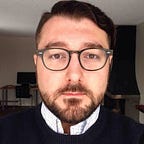Six Degrees of Bill Murray
Generative art and our power of recognition
Could you recognize a familiar face, perhaps one you’ve seen your whole life, if it were missing an ear or nose? Probably. Could you recognize that same face if it were made of geometric shapes and not flesh?
I began with a photograph of Bill Murray and through my study of generative art using the Processing library and Hype framework built a script attempting to render out the sampled image using only squares.
Through my script, a pointer would select a random spot on the full photograph of Bill Murray, sample its color value, and draw a square of randomized size and rotation at that space using that color. Like making a picture of rough construction paper.
But as with construction paper, we quickly realize that we need not only more pieces of paper, but for them to be smaller for any reasonable level of detail. This image is run in the same process as above, but contains a smaller minimum square size, and the equivalent of 9000 more pieces of ‘paper’ in use.
This is about the part where I thank the stars that I don’t have to do this by hand.
By decreasing the maximum size of squares in use and again increasing the count of squares used I believe this is the range where we might not only be able to recognize a face, but perhaps also its subject. Many more squares in use mean many more points of color reference, and in the image above we begin to see highlighting in what can be recognized as a forehead. The dark shapes of eyes and a mouth begin to form.
We can keep increasing the count of shapes drawn and reducing the size of the shapes until we are tracing pixel for pixel a reference image, but a perfect clone of the source image isn’t the goal. This is art, and we’re looking to create a representation of another object in a new form, a visual metaphor, the “aha!” moment.
Thanks to the generative magic of randomization and our quest for better expression of our idea, we also end up with plenty of outtakes. These three images were created with the same settings as the previous, but all have wildly divergent features depending on where the color sampling took place, and at times look comical and very far from our recognizable subject.
Pushing to an extreme in the image above, while looking “artistic,” also feels very boring to me. It’s an example of raising not only the number of squares used sky-high but in keeping them small and also allowing them a varying opacity.
While the image is now very recognizable as Bill Murray, all visual activity and movement has ceased and I feel it now simultaneously does a worse job at communicating its subject than the source photograph and is worse at its job of expressing “this is not a photograph!” than the more basic images we had previously. It is simply too realistic to be interesting.
As with any work, you have to decide when it’s close enough to what you originally wanted to express, and when you’ve gone too far into recapturing realism as to drain from the work any of its own originality or difference.
I’ll continue updating this category on generative art as well as the code/idea sketch repository as I create new work.
Your pal,
Douglas / @theDoug
